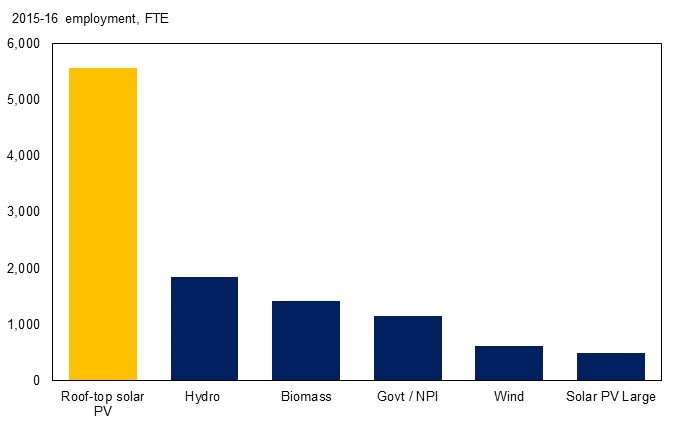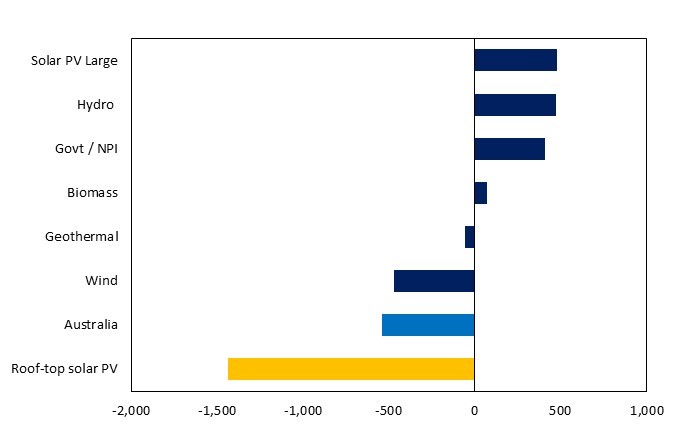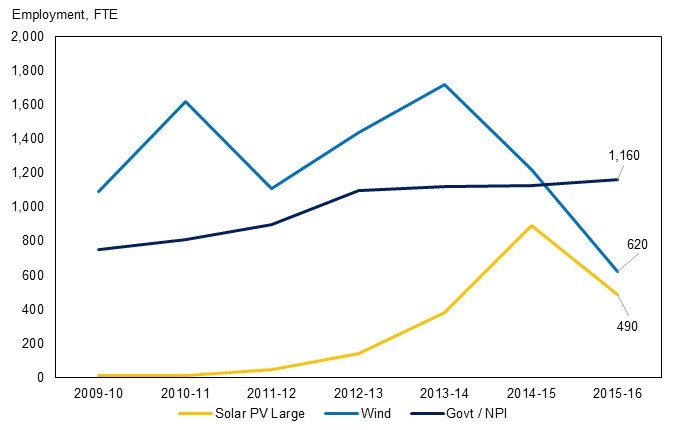Renewables and employment: Not all jobs and growth
The structural adjustment toward a lower carbon economy will include uncomfortable realities about job losses and gains. It is essential that governments are honest about these adjustments so that adequate planning takes place to support communities through the transition.
In Parliament on Tuesday, 21 March 2017 the Victorian Minister for Energy, Environment and Climate Change announced that the Victorian renewable energy target scheme will create 11,000 new jobs for Victorians[i].
Four days prior to the Minister’s comments however, the Australian Bureau of Statistics (ABS) released numbers which demonstrate that most of those jobs will be short term, during construction or underpinned by government and support functions[ii]. It is unlikely that this short term employment in new generation will offset the employment lost in traditional forms of generation being displaced. As the construction of new plant winds down there is likely to be a net reduction in direct employment in the energy industry.
The ABS reported that in 2015-16 annual direct full-time equivalent (FTE) employment in renewable energy activities in Australia was at 11,150. This is a decrease of 2,150 employees or 16 per cent from the previous year 2014-15 and a decline of 42 per cent (or 8,070 FTE) from a peak of 19,220 in 2011‑12. The ABS reports that employment in large scale solar and wind power is primarily driven by installation activity, rather than by ongoing operation and maintenance. Figure 1 shows the declining trend in renewable employment across all states.
Figure 1: Direct FTE employment in renewable energy, 2009-10 to 2015-16

Source: Australian Bureau of Statistics, 2017
The employment profiles of existing wind and solar plants show us that new forms of energy have a relatively smaller need for ongoing employment than traditional forms of generation, including hydro, gas or coal plants. AGL’s Macarthur Wind Farm employed up to 400 direct jobs at peak during construction, 875 jobs in the region, 2490 in Victoria, 2782 in Australia, and once construction was complete approximately 20 people were employed for ongoing work[iii]. The structural adjustment in employment in the energy industry as the sector decarbonises means moving to a less labour intensive generation mix.
The ABS data now demonstrates this structural change in action. The ABS attributes the rise in renewable energy employment between 2009-10 and 2011-12 to the employment of construction workers to build renewable energy facilities. However, once construction is completed and only ongoing maintenance is required, employment falls quite significantly, even though generation of renewable electricity remains higher.
In 2016, based on the available information, the Energy Council estimated that between 2011 and 2023 there will be around 1,611 FTE permanent jobs lost from the closure of thermal generation[iv]. Jobs gained or replaced in new large-scale generation are estimated to be 398 FTE permanent jobs over the same time.
Figure 2 shows that the majority of employment in renewables are in household level solar systems, but this sector of renewable employment is experiencing the greatest decline (see figure 3). It is hard to say when the market and employment in household solar will become mature. By comparing household data from the Census with solar data from the Clean Energy Regulator, the ABS estimate that 21 per cent of suitable dwellings already have solar, implying there is more expansion in the industry to come as the cost of solar declines.
Figure 2: 2015-16 employment (FTE no.) by type of renewable energy activity

Source: Australian Bureau of Statistics, 2017
Note: Rooftop solar includes solar hot water systems.
Figure 3: Change in employment (FTE no.) by renewable energy activity from 2009-10 to 2015-16

Source: Australian Bureau of Statistics, 2017
Note: Rooftop solar includes solar hot water systems. Australia is total national renewable energy employment.
It is unhelpful for politics to misrepresent the true cost of the challenge to decarbonise the energy sector and our economy, including the impact on employment. The reality is that new generation technologies such as solar, wind and battery storage require very little ongoing employment. These technologies help us to achieve lower emissions, but they are unlikely to result in a net increase in employment.
Interestingly, the ABS data also reveals that employment in government and the not for profit (NPI) sector is holding up quite well as employment in energy production itself decreases. The ABS measures employment in activities undertaken by employees of government agencies and NPIs to support the operation of renewable energy systems, for example, administration, legal, policy or advocacy. It is these kinds of administrative functions in government and not for profits which support actual production of energy which may drive the ongoing permanent employment numbers in the future. Figure 4 shows that in 2015-16 employment in government and NPIs is larger than those employed in all utility wind and solar energy generation.
Figure 4: Employment in government and administrative functions holding up well, relative to employment in solar and wind

Source: Australian Bureau of Statistics, 2017
This creep in government and administrative sector employment is a cost to tax payers and the economy. While it costs taxpayers to administer a given set of government rules (such as the Renewable Energy Target, reliability target or green schemes), it costs businesses and consumers to comply with those rules. The cost of complying with public sector regulation as a whole is estimated at around 4.2 per cent of national income – or around $67 billion per year[v]. Such costs also displace other expenditure by governments, households and businesses that would have underpinned employment. So these administrative employment figures do not represent incremental employment in the economy - which will be lower or possibly negative. The rules we have put in place to decarbonise the energy sector have big benefits as well, and we need to make sure we are getting good value from the regulations we put in place – both those set by governments and those self‑imposed by organisations to decarbonise the sector.
[i] Parliament of Victoria, 2017, Questions without notice and ministers statements: energy security, Legislative Assembly 21 March 2017.
[ii] Australian Bureau of Statistics, 2017, Employment in Renewable Energy Activities, Australia, 2015-16, cat. no. 4631.0, http://www.abs.gov.au/ausstats/abs@.nsf/mf/4631.0
[iii] AGL, 2013, Largest Wind Farm in the Southern Hemisphere officially opens, https://www.agl.com.au/about-agl/media-centre/article-list/2013/apr/largest-wind-farm-in-southern-hemisphere-officially-opens
[iv] Australian Energy Council, 2016, Jobs gains and losses in the energy transformation, https://www.energycouncil.com.au/analysis/jobs-gains-and-losses-in-the-energy-transformation/
[v] Deloitte, 2015, Get out of your own way: Unleashing productivity, https://www2.deloitte.com/content/dam/Deloitte/au/Documents/Building%20Lucky%20Country/deloitte-au-btlc-get-out-your-own-way-230217.pdf
Related Analysis
Certificate schemes – good for governments, but what about customers?
Retailer certificate schemes have been growing in popularity in recent years as a policy mechanism to help deliver the energy transition. The report puts forward some recommendations on how to improve the efficiency of these schemes. It also includes a deeper dive into the Victorian Energy Upgrades program and South Australian Retailer Energy Productivity Scheme.
2025 Election: A tale of two campaigns
The election has been called and the campaigning has started in earnest. With both major parties proposing a markedly different path to deliver the energy transition and to reach net zero, we take a look at what sits beneath the big headlines and analyse how the current Labor Government is tracking towards its targets, and how a potential future Coalition Government might deliver on their commitments.
The return of Trump: What does it mean for Australia’s 2035 target?
Donald Trump’s decisive election win has given him a mandate to enact sweeping policy changes, including in the energy sector, potentially altering the US’s energy landscape. His proposals, which include halting offshore wind projects, withdrawing the US from the Paris Climate Agreement and dismantling the Inflation Reduction Act (IRA), could have a knock-on effect across the globe, as countries try to navigate a path towards net zero. So, what are his policies, and what do they mean for Australia’s own emission reduction targets? We take a look.
Send an email with your question or comment, and include your name and a short message and we'll get back to you shortly.



